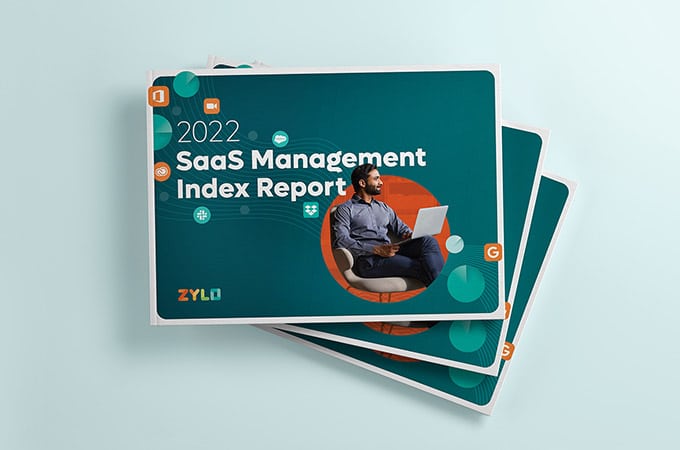
Does the CIO Really Need to Control the Entire Tech Budget?
Table of Contents ToggleThe 2022 Technology Trends to Watch forTech Trend...
Back
Back
Search for Keywords...
Blog

01/27/2022
Table of Contents
If you’re still only using on-premise applications in your technology stack, you’re about to be left behind. SaaS use is growing and is the way of the future for successful businesses.
In fact, Gartner forecasts spending on public cloud services to reach $483 billion in 2022. By 2026, SaaS spending will account for more than 45% of all enterprise IT spending.
Cloud-based software is proliferating faster than expected. While companies were planning to slowly transition to the cloud just a few years ago, they’re realizing that they need to accelerate those changes now.
To help you stay ahead of the curve, we put together a list of five predictions for 2022 technology trends—including the rise of the next CIO and the evolution of SaaS Management.
The pandemic accelerated the growth of SaaS purchases—and it’s not just Zoom calls we’re talking about, here. Companies now rely on everything from Human Capital Management to digital gifting as they look to support their hybrid workforce and customer base. As more people look to the flexibility of remote work, companies must prepare for a new digital and distributed workforce. Let’s jump into the 2022 technology trends you should pay attention to.
Nearly any work that could be done digitally, went digital at the start of the pandemic. While we may end up back in the office someday, the likely bet is that we’re entering a new age of hybrid and remote work. That’s because the meaning of work has changed from pre-pandemic times.
“The importance of flexibility in the workplace of the future is key in combating what’s called the Great Resignation”
– Helen Kupp, Future Forum Data, SaaSMe CIO Panel
Creating a digital workplace, where remote workers can effectively collaborate in the cloud, is part of how SaaS will become crucial in the future. Your job is no longer tied to a physical office, because “work isn’t a place you go, it’s what you do,” says Bret Taylor, President and COO at Salesforce.
As we all adjust to the new normal, these changes come with their own set of challenges in 2022 as companies work to adapt to a digitally driven workforce.
The process of digital transformation is also evolving. 2022 brings a new mandate to become a digitally mature organization that can handle the complexities of a distributed workforce. To accomplish this, you must effectively manage your technology stack and focus on establishing a foundation for your digital success.
To make the shift and drive digital transformation without letting your costs run rampant, start tracking usage and cost metrics like:
As SaaS continues to grow, one thing is for sure about this IT trend in 2022 – only the digitally dexterous will succeed in the future.
A new type of CIO is emerging to manage our increasingly digital and cloud-based workplace. This progressive CIO will become a central leader in the greater organization as they juggle the challenges that come with the “new normal.”
Their main priorities are:
The next CIO also needs to build a close working relationship with their organization’s CFO. The goal is to introduce a shift from viewing IT as a cost center to viewing it as a revenue generator for the business by recouping operational costs.
According to Kathryn Guarini, CIO at IBM, CIOs are helping “drive innovation to break down silos across the organization and create new value streams.” The key here? Stop operating IT as a silo. “They serve as connectors across business functions and are engaging more with the CEOs to develop technology strategies that drive agility and efficiency, and ultimately, lead to business growth,” Guarani concludes.
The past two years forced companies to respond to external changes in the workforce, including the rising demand for remote work and the ability for customers to do business virtually. For 2022, they can start focusing on strategic alignment between IT and the business.
Here is where the progressive CIO will bring IT teams out into the business to support and collaborate with other departments. Instead of the disconnect that brings about shadow IT, we’re seeing a new framework where IT is a true organizational enabler, instead of a gatekeeper for the tools business units need to accomplish their work.
For decades, entire departments and Software Asset Management teams were tasked with managing on-premise licenses and making sure they were being used.
Today, SaaS use is growing so quickly that it will become the majority of all software in the next three years, according to Bessemer Venture Partners. By providing great products that give organizations purpose built solutions for their problems, Cloud (from hosting data to implementing SaaS) has become the next pillar of technology.
As SaaS becomes the dominant technology, we’ll need a new type of Software Asset Management professional. This SaaS Manager can help teams stay strategic and provide value to the business by managing and optimizing systems for the long term.
These SaaS specialists will help organizations manage adoption, optimization, and even reduce risk—supporting the new CIO’s vision every step of the way.
To get access to our industry-leading benchmark report and learn more about 2022 technology trends, sign up for Zylo’s 2022 SaaS Management Index.

Table of Contents ToggleThe 2022 Technology Trends to Watch forTech Trend...

Table of Contents ToggleThe New Role of the CIOWhy the CIO...

Table of Contents ToggleWhat has your research uncovered that can help...

| Cookie | Duration | Description |
|---|---|---|
| cookielawinfo-checkbox-analytics | 11 months | This cookie is set by GDPR Cookie Consent plugin. The cookie is used to store the user consent for the cookies in the category "Analytics". |
| cookielawinfo-checkbox-functional | 11 months | The cookie is set by GDPR cookie consent to record the user consent for the cookies in the category "Functional". |
| cookielawinfo-checkbox-necessary | 11 months | This cookie is set by GDPR Cookie Consent plugin. The cookies is used to store the user consent for the cookies in the category "Necessary". |
| cookielawinfo-checkbox-others | 11 months | This cookie is set by GDPR Cookie Consent plugin. The cookie is used to store the user consent for the cookies in the category "Other. |
| cookielawinfo-checkbox-performance | 11 months | This cookie is set by GDPR Cookie Consent plugin. The cookie is used to store the user consent for the cookies in the category "Performance". |
| viewed_cookie_policy | 11 months | The cookie is set by the GDPR Cookie Consent plugin and is used to store whether or not user has consented to the use of cookies. It does not store any personal data. |
